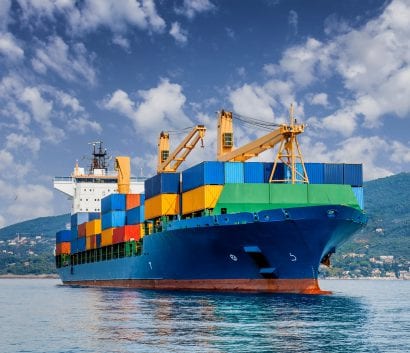Maritime Industries: Marine Transportation
Marine Transportation

Image of a container vessel. Photo by: @ilfede iStock/Getty Images Plus
Marine transportation workers perform various tasks while working on waterborne vessels that transport goods and people, or perform services. Many sub-industries within marine transportation use specialized vessels to accomplish specific duties or transport-specific cargo. Examples of this include tug and towboats, barges, container ships, bulk cargo ships, and ferry and cruise passenger vessels.
Marine transportation workers face a variety of unique work hazards1,2. Physical hazards include noise levels, vibration, ultraviolet light exposure, line handling, heavy lifting, slippery surfaces, steep ladders, and narrow passageways, and can be exacerbated by severe weather conditions. Chemical hazards include exposures to chemical cargos, fuel, cleansers, and diesel exhaust. Biological hazards include the transmission of contagious diseases between coworkers and travel-related infections. Psychosocial risks remain a significant challenge,3-8 including social isolation, language barriers, circadian rhythm disruption, substance abuse, low job control/high demand, harassment/bullying (43% prevalence in Nautilus study),9, and the fear of piracy internationally. Additionally, the months-long assignments with restricted shore leave raise the possibility that workers could face decreased or delayed access to medical care.
In 2016, there were approximately 67,000 workers in the U.S. water transportation industry.10 Inland waterways represents around 26,000 workers. Deep-Sea, Coastal, and Great Lakes Water Transportation represent about 36,000 workers11. From 2011–2017, there were 87 fatal injuries (18.4 per 100,000 workers)12 among marine transportation workers, nearly six times the rate of all U.S. workers. Studies show a high burden of fatalities due to cardiovascular conditions, work accidents, drownings (including from vessel disasters), suicides, and workplace violence.13,5 BLS data on the U.S. workforce (2011–2017) indicate a substantial number of deaths due to workplace violence and drownings. In the same period, there were approximately 11,000 nonfatal occupational injuries.14 Seafarers experience high rates of injury and illness,15,16 with a high proportion of upper extremity, lower extremity, and back injuries resulting in disability.12
- Carter T, Jepsen JR [2014]. Exposures and health effects at sea: report on the NIVA course: Maritime Occupational Medicine, Exposures and health Effects at Sea: Elsinore, Denmark, May 2014. Int Marit Health 65(3):114–121.
- Oldenburg M, Baur X, Schlaich C [2010]. Occupational risks and challenges of seafaring. J Occup Health 52(5):249–256.
- Iversen RT [2012]. The mental health of seafarers. Int Marit Health 63(2):78–89.
- Jeżewska M, Leszczyńska I, Jaremin B [2006]. Work related stress in seamen. Int Marit Health 57(1–4):66–75.
- Roberts SE, Jaremin B, Lloyd K [2013]. High-risk occupations for suicide. Psychol Med 43(6):1231–1240.
- Oldenburg M, Jensen HJ, Wegner R [2013]. Burnout syndrome in seafarers in the merchant marine service. Arch Environ Occup Health 86(4):407–416.
- Sampson H, Thomas M [2002]. The social isolation of seafarers: causes, effects, and remedies. Int Marit Health 54(1–4):58–67.
- Stannard S, Vaughan C, Swift O, Robinson G, Altaf SA, McGarry A [2015]. Women seafarers’ health and welfare survey. Int Marit Health 66(3):123–138.
- Nautilus International [no date]. Report: Bullying, Discrimination & Harassment Survey 2010. London, UK: Nautilus International, http://m.nautilusint.org/media/169246/Bullying-Discrimination-Harassment-survey-2010.pdfpdf iconexternal iconpdf iconexternal icon.
- BLS [2017]. NAICS 483 Water transportation, all states and U.S., 2016 Annual averages, all establishment sizes. In Quarterly Census of Employment and Wages. Washington DC: U.S Department of Labor, Bureau of Labor Statistics, https://data.bls.gov/cew/apps/data_views/data_views.htm#tab=Tablesexternal iconexternal icon.
- BLS [2017]. May 2017 National Industry-Specific Occupational Employment and Wage Estimates. NAICS 483000 – Water Transportation. In Occupational Employment Statistics. Washington, DC: U.S. Department of Labor, Bureau of Labor Statistics, https://www.bls.gov/oes/current/naics3_483000.htmexternal iconexternal icon.
- BLS [2016]. Census of Fatal Occupational Injuries (2011 forward), all U.S., all ownerships, water transportation. In Census of Fatal Occupational Injuries. Washington DC: U.S. Department of Labor, Bureau of Labor Statistics, https://www.bls.gov/data/#injuriesexternal iconexternal icon.
- Roberts SE, Jaremin B, Chalasani P, Rodgers SE [2010]. Suicides among seafarers in UK merchant shipping, 1919–2005. Occup Med 60(1):54–61.
- BLS [2016]. Table 2. Numbers of occupational injuries and illnesses by industry and case types, 2011–2014. In Survey of Occupational Injuries and Illnesses. Washington DC: U.S. Department of Labor, Bureau of Labor Statistics, https://www.bls.gov/iif/oshsum.htmexternal iconexternal icon.
- Lefkowitz RY, Slade MD, Redlich CA, et al. [2015]. Risk factors for merchant seafarer repatriation due to injury or illness at sea. Int Marit Health 66(2):61–66.
- Lefkowitz RY, Slade MD, Redlich CA [2015]. Injury, illness, and work restriction in merchant seafarers. Am J Ind Med 58(6):688–696.
